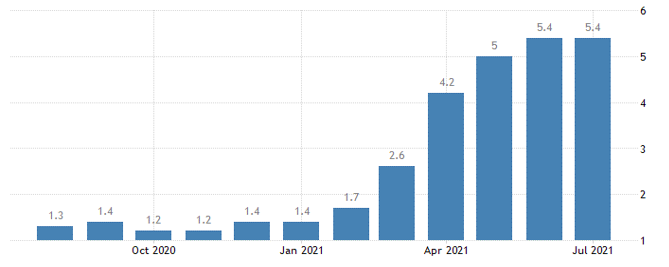
SOURCE: “United States Inflation Rate,” Tradingeconomics.com, accessed Aug. 11, 2021.
WHAT IS INFLATION?
Broadly, inflation refers to an increase in prices over time. It’s tracked through several metrics, but the best-known is the Consumer Price Index (CPI), maintained by the U.S. Bureau of Labor Statistics. (Others include the Producer Price Index [PPI], which looks at the prices that companies pay for goods and services, and the Personal Consumption Expenditures Price Index [PCEPI], which is similar to the CPI but measures price changes in a different set of products.)
As of July 2021, the CPI rose by 0.5 percent, rising 5.4% over the last 12 months and the PCEPI rose to 4% as of June 2021.2,3 That is significantly higher than the Federal Reserve’s long-term target rate of 2% and the PCEPI 2021 median projected inflation of 3.4%.4 (For the past 10 years, the monthly reading has averaged just 1.7%.5) The increase is likely due to increased demand for goods and services as the pandemic eases and the U.S. economy gathers momentum. Some experts believe that the inflation threat is still limited and that short-term spikes in prices are due to abnormally high demand for products and limits on some goods due to supply-chain issues. A related factor is that the CPI tracks year-over-year increases, and April 2020 was an outlier month with minimal demand because of COVID-19 lockdowns, which makes comparisons seem larger than they might normally be.
But there are real reasons for investors to watch the inflation numbers and remain wary. One is that the U.S. government has spent several trillion dollars on stimulus packages to mitigate the fallout from COVID-19.6 That comes in addition to very low interest rates, which spur business activity. There’s a chance that those efforts could potentially be too successful, causing the economy to rebound faster than expected.5 A second reason is that the mere prospect of inflation can sometimes create the real thing. If consumers believe that prices are rising, they rush to make purchases today that they normally would put off. That boosts demand, which in turn pushes up prices, leading to a self-reinforcing cycle.7
FINANCIAL MOVES IN AN INFLATIONARY ENVIRONMENT
What does increasing inflation mean for your clients? One is that if the Federal Reserve sees inflation as a threat, it is likely to boost interest rates to slow an overheating economy. If your clients are considering large purchases that require financing—like a home—they should look to move quickly, before a potential rise in lending rates. Similarly, if they have high levels of debt at floating rates, they should refinance those at fixed rates to avoid an escalation in payments in the future.
For investors who are holding cash, inflation means that those assets will lose value in terms of their purchasing power. If you could buy a given product for $100 today and instead decide to keep that money in your wallet, you won’t be able to make the same purchase a year from now. Simply stated, a 5% annual inflation rate means the same $100 will no longer be enough a year from now, having fallen to $95 in purchasing power. Instead, financial clients may want to explore investing that cash into asset classes that may serve as a hedge against inflation. Traditional income investors who hold bonds may also be at risk in an inflationary environment, as the fixed returns of those assets could be outpaced by inflation.
Investors seeking to hedge inflation—whether through alternative income streams or growth opportunities— have multiple options. Some include:
- Private equity
- Public equities
- Real Estate
- TIPS bonds
- Floating Rate Loans
- Gold
- Silver
What to look for in inflation-hedged investments:
- Real assets are often used because they have an intrinsic value that increases with inflation. Contrast that with nominal assets like CDs, which are priced based on the fixed interest they pay and thus lose value as inflation rises.
- Investment types that are indexed to inflation are often used. For example, some categories of bonds ratchet up their payouts in line with inflation, preserving their overall value to investors.
- When looking at debt instruments, those with a long duration tend to lose value during periods of rising inflation. However, loans with shorter duration or floating-rates that increase the payout in response to hikes in interest rates caused by inflation, may perform better.
- Certain companies may see cash flows and underlying valuations rise with inflation. Primarily, these are companies with well-established brands and/or pricing power to help offset rising costs. Similarly, some B2B sectors have historically performed well during periods of inflation, because they can pass their costs along to customers.8
At this point, increasing levels of inflation are more of a risk consideration. Concerned financial professionals and their clients may benefit from diversifying before—rather than after—inflation erodes the value of their investments.
1 “Historical Inflation Rates: 1914-2021,” U.S. Inflation Calculator, accessed Aug. 5, 2021.
2 “United States Consumer Price Index (CPI).” U.S. Bureau of Labor Statistics, accessed Aug. 11, 2021.
3 “Personal Consumption Expenditures Price Index,” Bureau of Economic Analysis, July 30, 2021.
4 “PCE Inflation,” Summary of Economic Projections, Board of Governors of the Federal Reserve System, June 16, 2021.
5 Frank Holmes, “Inflation is Coming for Your Wealth. Here’s What Investors Can Do About It,” Forbes.com, Feb. 26, 2021.
6 Anneken Tappe, “All that stimulus is sending inflation higher,” CNN.com, April 9, 2021.
7 Neil Irwin, “Inflation is Here. What Now?” NYTimes.com, May 13, 2021.
8 Debbie Carlson, “6 Investments to Offset Potential Inflation,” USNews.com, Sept. 14, 2020.
CSC-0722-2267589-INV-E

